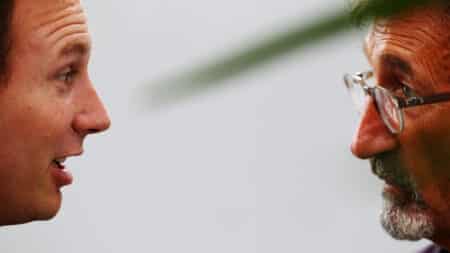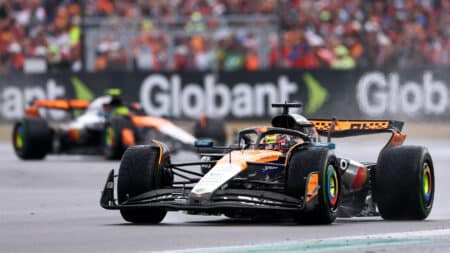
Horner's departure shows age of the maverick F1 boss is over
Christian Horner has now left Red Bull, the last of a certain breed of F1 team principal
A great deal of unhappiness and toxic comment has been aired on the web about the Rolex 24 Hours at Daytona. Many fans were displeased with the excessive, unnecessary use of yellow flags and other manifestations of NASCAR’s mentality. More than a few also lamented the absence of LMP1-type cars and are struggling to accept the fact that high-profile factory teams from Europe and Japan and modern, high-tech cars are things of the past for American sports car racing.
Meanwhile, an investigation into Memo Gidley’s crash has been launched as Gidley underwent a second surgery at the end of last week to repair damage to his left ankle. More surgery is expected next week to work on an unspecified fracture to Gidley’s back. Bob Stallings, owner of the Gainsco team, spent most of last week at Gidley’s beside. Stallings is a true sportsman with a big heart and he’s pledged to support Gidley every step of the way through his rehabilitation.
As Gidley begins his long road to recovery the Tudor United SportsCar series looks forward to round two at Sebring in March. The substantially lighter P2 cars (by 300 pounds) are expected to be more competitive on the tighter confines of Sebring’s bumpy airfield circuit than they were on the high banks of Daytona and it’s possible that the P2 cars will be saddled with a weight penalty for Sebring. We’ll see.
Like it or not, ‘performance balancing’ is essential to NASCAR and the TUSC and regular adjustments to ‘level the playing field’ are expected to be stock-in-trade for the new series.
As much as many road racing fans don’t like this way of doing business, a large number of them were equally unhappy with the television coverage and live-streaming of this year’s Rolex 24. There’s no question that the TUSC must do a better job in this department as they will have to work very hard to try to attract more mainstream media coverage of the series.
There wasn’t a single word from Daytona in the New York Times, Boston Globe or other northeastern newspapers and the only coverage of the race in USA Today was all about Gidley’s accident.
Indeed, the media centre at Daytona was very sparsely populated. I believe the Daytona Beach News Journal was the only American newspaper represented, plus the AP’s national racing writer. Most of the reporters at Daytona came from Europe with a total of 10 or so writers from the UK, Germany, Italy, France and Holland.
The sad fact is that the TUSC and IndyCar have become two of the smallest sports in America today. Incredibly, over the past 10 years the overall media footprint in the United States for these forms of racing have fallen well behind the American media coverage of Major League and Premier League soccer!
This is a big problem for American motor racing and a key reason why it’s so difficult to sell sponsorship for either the TUSC or IndyCar. In fact, increasing the TUSC’s tiny media footprint is as big a challenge for both series as solving the conundrum of finding the right technical formula for the future.
Meantime, at the end of last week, NASCAR’s chairman and CEO Brian France announced yet another revision to the Sprint Cup championship. This is the fourth change NASCAR had made to its championship methodology in the past 11 years.
This year, 16 drivers – four more than in recent years – will take part in the ‘Chase for the Cup’ over the year’s final 10 races. Those 16 will be whittled down to four for the final NASCAR race at Homestead-Miami Speedway in November. If the system had been in effect last year, Dale Earnhardt Jr would have won the championship without winning a single race.
Brian France says NASCAR has done considerable research into how to tweak its championship formula. France says NASCAR is listening to its fans and responding to what they want as well as adapting to the changing requirements of the highly competitive American sports market.
NASCAR hopes to attract a broader audience with these changes but many racing fans who are not fans of NASCAR are shaking their heads over the immutable changes it has made to the championship over the past 11 years. They’re the kind of moves that make many people even less interested and more dismissive of NASCAR as a serious form of motor racing.
Here’s hoping that kind of NASCAR thinking doesn’t entirely overtake the TUSC. Unfortunately, many fans believe this unhappy transformation already has occurred.
More from Gordon Kirby
Action Express wins Daytona 24 Hours
The United SportsCar Series arrives
Parnelli’s record run in the Baja 1000

Christian Horner has now left Red Bull, the last of a certain breed of F1 team principal

Was Oscar Piastri the real winner in the long run after Silverstone? asks James Elson

Lewis Hamilton hadn't won in almost three years – and then produced a sensational victory at Silverstone 2024. James Elson explains why it was his best ever

Describing this year's championship race as a 'battle' might be slightly over-egging it, writes James Elson